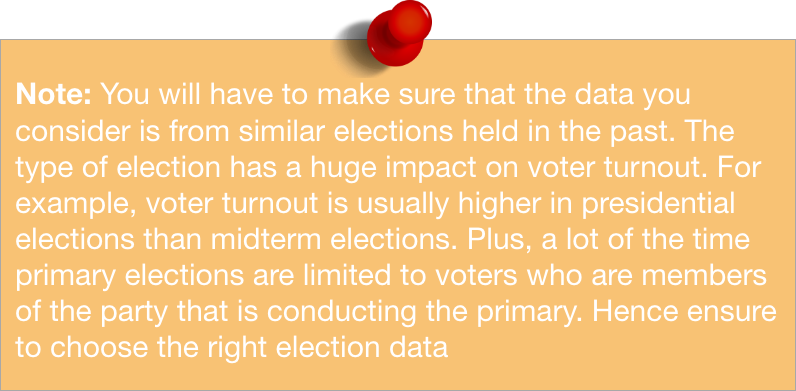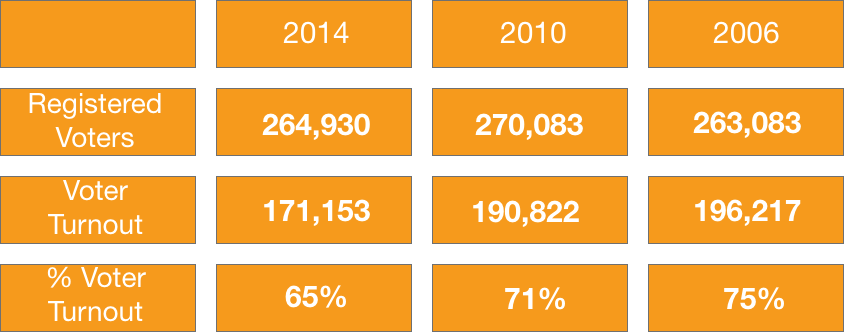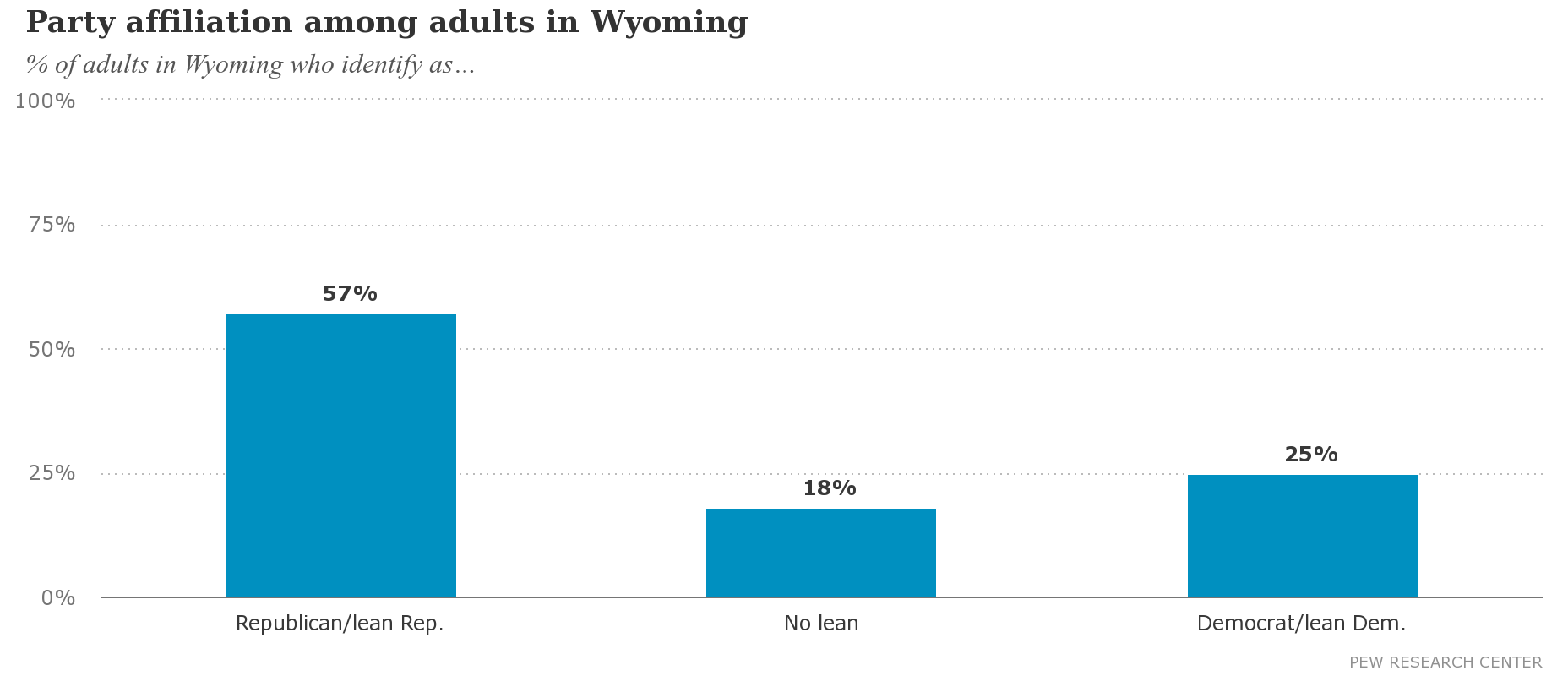Table of Contents
Why is determining your win number important?
1 Vote.
One vote is all it took for Republican George Wiggins to defeat Democrat Fred Belair in the New Hampshire Senate elections in 1982. George Wiggins secured 5,352 votes, whereas Fred Belair secured only 5,351 votes.
This example makes it quite clear that to win an election, you don’t need to convince many people to vote for you; you just need to convince enough.
So, how do you find out how many people are “enough”? This article will examine that question.
What is a Win Number?
Your “Win Number” is the minimum number of votes you need to secure a majority and win an election. It’s as simple as that.
Every political campaign begins with determining a win number.
Why?
Because your win number is the objective of the whole campaign (or at least it encompasses it). It is what you set out to achieve.
So, how do you calculate the win number for elections you are competing for?
How to calculate your win number
To better understand how to calculate your win number, let’s walk through a real example.
Imagine your candidate is competing for the US Senate in the 2018 midterm elections from the district of Wyoming. We will work with voter registration and turnout statistics from the Wyoming Election Division here.
Another assumption we’ll make is that your candidate has already passed the primary and is now up for the general election.
Here’s how you’d go about calculating your win number:
Step 1: Calculating the expected voter turnout
The first step towards determining your win number is knowing how many people you expect to come out and vote. Not just for your candidate but overall.
Why do you need it?
The expected voter turnout estimates the number of eligible voters who will cast a ballot in the elections. This number will help you get the estimated number of votes you’ll need in your favor to win.
Since several factors affect voter turnout, the exact number is nearly impossible to determine.
However, working with an expected number is good enough to set an objective for you.
How to calculate voter turnout
Determining the expected voter turnout is quite a simple calculation. All you need is the voter turnout from the past few terms.

Generally, voter registration and turnout data are available at the district’s voter registrar office. However, this data is usually also available online.
Per our assumption, your candidate is competing in the general midterm elections. Going by the data we have for Wyoming from the sources above, here are the numbers:

The formula to calculate the expected turnout is quite simple:

The % average expected ballots as per our data is:
(65%+91%+75%)/3 = 77%
Number of registered voters = 276,696
So, the expected voter turnout for the next general midterm elections can be calculated as:

Now that you have an estimate of the number of people who will turn up to vote during the elections, you can proceed to the next step.
Step 2: Calculating the vote goal
After determining the expected voter turnout, the next step is to define the vote goal. This is the approximate number of votes you’ll need to secure a clear majority and win.
Why do you need it?
With a vote goal in mind, you’ll get an idea of the minimum number of voters you need to convince to support you. A vote goal will allow you to prioritize your target voters and plan your outreach strategies.
For instance, if you’re planning to reach out to voters through phone banking, you know you only need to call a specific number of people (typically the swing voters) in an area and not everyone.
This, in turn, is important to ensure that your campaign resources are utilized well.
How to calculate your vote goal
In an ideal world, you’d only need 50% of all votes plus 1 to secure a majority. But since several factors are in play during elections, it’s safe to take a margin of 3%.
So, getting 53% of the votes would be a good enough number to ensure a win.
But again, you can’t be sure about successfully reaching out to exactly 53% of the population and converting everyone. Hence, an extra safety margin of around 20% is considered.
You can increase the safety margin in states where you might not be a clear majority.
Let’s assume a safety margin of 20% for our example.
Bringing it all together, the formula to calculate your vote goal is as follows:

Based on this, our Vote Goal (also referred to as the Win Number) is calculated by:

So as per the data from Wyoming, the basic win number for your party competing in the next elections would be:

The Vote goal for the elections would be:

Therefore, to win the next elections, your candidate must target at least 135,502 voters to gather their support and secure a majority.
Now, if we take a look at the actual numbers of the Wyoming 2018 general midterm elections, here is what we have:

You can take a look at the results of the election here.
Now that you have your win number, what do you do next?
How to strategize your targeting based on your win number
To strategize voter targeting, your first step would be to classify all voters into different segments. Typically, these segments comprise of the following:
- Strong supporter
- Supporter
- Undecided (Swing Voter)
- Not a supporter
- Strong Opposition
By running an effective voter identification campaign, you can classify all registered voters into these segments.
For more insights into how to run a voter identification campaign, you can refer to this article: How to run a voter id campaign with Votebuilder
1. Party Supporters (% share):
As per the above segments, this chunk of people comprises your strong supporters and supporters.
People voting for your party or showing a keen interest in your party’s objectives qualify for this segment.
How do we target them?
Strong supporters will not require a lot of effort to convince them to vote for you.
You can involve them in your campaigning efforts by encouraging them to help spread your message and draw in more supporters from their networks or communities.
Conversely, supporters consist of people who support your candidate but might not be motivated enough to come out and vote. Hence, your primary goal while targeting them would be to convince them to get out and vote on election day.
A peer-to-peer texting campaign accompanied by a social media or email campaign would be a good way to motivate these supporters.
2. Undecided or Swing Voters (% share):
This group of people would be those who don’t have a strong opinion of any of the parties.
This segment includes those who haven’t consistently supported a particular party in the past. It can also include first-time voters or fresh voters.
How to target them
This segment is the most crucial segment for your targeting efforts. A significant part of your campaign resources should be used to win over swing voters.
Your goal for this group would be to inspire them to believe in your party’s objectives and vote on election day.
Targeting them would require conducting a good mix of online and offline targeting campaigns.
Your offline efforts would typically include phone banking, peer to peer texting, door to door canvassing, and community meetings/rallies.
Online efforts would be supported by media ads, social media campaigns, emails, and your party website.
3. Opposition Supporters (% share)
This segment consists of people who are not rooting for you or strongly opposing you. Individuals who are keen on the objectives of the opposition parties or those who strongly oppose your ideologies qualify for this segment.
How to target them?
Targeting this group of people may not benefit your party. However, resources are not a restriction; you could target the “not supporter” segment to bring them on your side.
You will have to target this segment with highly personalized campaigns supported by phone banking or door-to-door canvassing.
To turn this group of people, your volunteers/candidates will have to address their issues in person to understand the reasons they believe in the opposition and what you could do to get their support.
>> For a more detailed understanding of how to persuade your target voters, check out this article: 3 step guide to persuading your target voters
Getting back to how this segmenting will help you with your vote goal. Well, let’s go back to the Wyoming election example.
Going by the party affiliation data as given by the Pew Research Center, here’s what we have:

In case you’re a candidate from the democratic party, here’s how you can plan your targeting:
Party supporters
25% X Expected voter turnout = 53,263
You’ll target this group of people using GOTV campaigns and encouraging peer-to-peer awareness campaigns.
Swing Voters
18% X Expected voter turnout = 38, 349
You must reach out to this set of people using partisan campaigns.
Based on this, your vote goal deficit comes out to

Opposition supporters
18% X Expected voter turnout = 121,441

Hence, the vote goal allows you to better plan the type of outreach campaigns you can employ to achieve it.
What’s after you determine your win number?
Once you have your win number, reach out to your supporters and begin your outreach campaigns. Identify voters, build a strong case for your candidate, and get out the vote! If you want more resources, you can try reading 7 strategies for effective voter outreach
You can also watch CallHub’s webinar on microtargeting to identify and win support.


